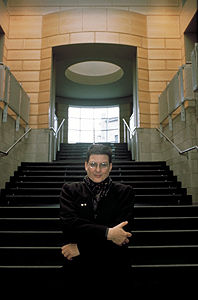Browse "People"
-
Article
Phillips Motley
Phillips (Carey) Motley. Organist-choirmaster, conductor, b Montreal 12 Jul 1912; BA (McGill) 1934, LRSM 1935, B MUS (Toronto) 1939, FRCCO 1940. Studies in Montreal with R.F.L.
"https://development.thecanadianencyclopedia.ca/images/tce_placeholder.jpg?v=e9dca980c9bdb3aa11e832e7ea94f5d9" // resources/views/front/categories/view.blade.php
https://development.thecanadianencyclopedia.ca/images/tce_placeholder.jpg?v=e9dca980c9bdb3aa11e832e7ea94f5d9
-
Article
Phineas Riall
Riall arrived in UPPER CANADA in August 1813 and was placed in command of the Right Division, a geographic entity in the NIAGARA PENINSULA.
"https://d2ttikhf7xbzbs.cloudfront.net/media/media/f9b156d0-574f-4ba2-94ae-1c4e1895a1fb.jpg" // resources/views/front/categories/view.blade.php
https://d2ttikhf7xbzbs.cloudfront.net/media/media/f9b156d0-574f-4ba2-94ae-1c4e1895a1fb.jpg
-
Article
Phylis Inglis
Phylis (Elizabeth) Inglis (b Dilworth). Pianist, voice teacher, b Victoria, BC, 23 Nov 1916; LRSM 1936, BA (British Columbia) 1940. A niece of Ira Dilworth, she studied piano with Gladys Hewlings in Victoria and 1934-44 with Isabel Campbell in Vancouver.
"https://development.thecanadianencyclopedia.ca/images/tce_placeholder.jpg?v=e9dca980c9bdb3aa11e832e7ea94f5d9" // resources/views/front/categories/view.blade.php
https://development.thecanadianencyclopedia.ca/images/tce_placeholder.jpg?v=e9dca980c9bdb3aa11e832e7ea94f5d9
-
Article
Phyllis Bomberry
Phyllis “Yogi” Bomberry, softball player, artisan (born 1943 in Ohsweken, Six Nations of the Grand River, ON; died 3 January 2019). Phyllis Bomberry was a catcher for women’s softball teams in Toronto and on the Six Nations of the Grand River. She helped lead her teams to championships with superb hitting and stellar defence. As an Indigenous athlete, Bomberry was often the target of bigotry and discrimination. Bomberry was the first woman to win the Tom Longboat Award as the top Indigenous athlete in Canada (see also Tom Longboat). She was nicknamed Yogi, likely in reference to the great New York Yankees catcher Lawrence ‘Yogi’ Berra, as a result of her skills as a catcher and batter.
"https://development.thecanadianencyclopedia.ca/images/tce_placeholder.jpg?v=e9dca980c9bdb3aa11e832e7ea94f5d9" // resources/views/front/categories/view.blade.php
https://development.thecanadianencyclopedia.ca/images/tce_placeholder.jpg?v=e9dca980c9bdb3aa11e832e7ea94f5d9
-
Article
Phyllis Cooke
Phyllis (Angela) Cooke (m Thomson). Soprano, b Winnipeg 14 May 1934. She studied voice in Winnipeg with Doris Mills Lewis and won top honours (Tudor Bowl 1952, Rose Bowl 1956) in the Manitoba Music Competition Festival. Later studies were with Lucien Needham and Victor Martens.
"https://development.thecanadianencyclopedia.ca/images/tce_placeholder.jpg?v=e9dca980c9bdb3aa11e832e7ea94f5d9" // resources/views/front/categories/view.blade.php
https://development.thecanadianencyclopedia.ca/images/tce_placeholder.jpg?v=e9dca980c9bdb3aa11e832e7ea94f5d9
-
Article
Phyllis Dewar
Phyllis Dewar, swimmer (b at Moose Jaw, Sask 5 Mar 1916; d at Toronto 8 Apr 1961). Spurred from age 4 by a strong competitive instinct, Dewar was the best swimmer on the prairies by age 17.
"https://development.thecanadianencyclopedia.ca/images/tce_placeholder.jpg?v=e9dca980c9bdb3aa11e832e7ea94f5d9" // resources/views/front/categories/view.blade.php
https://development.thecanadianencyclopedia.ca/images/tce_placeholder.jpg?v=e9dca980c9bdb3aa11e832e7ea94f5d9
-
Article
Phyllis Gotlieb
Phyllis Fay Gotlieb, née Bloom, poet, short story writer, novelist (born at Toronto 25 May 1926, died there 14 Jul 2009). Phyllis Gotlieb was raised and educated in Toronto and attended the University of Toronto (BA, 1948; MA 1950).
"https://development.thecanadianencyclopedia.ca/images/tce_placeholder.jpg?v=e9dca980c9bdb3aa11e832e7ea94f5d9" // resources/views/front/categories/view.blade.php
https://development.thecanadianencyclopedia.ca/images/tce_placeholder.jpg?v=e9dca980c9bdb3aa11e832e7ea94f5d9
-
Macleans
Phyllis Gotlieb (Profile)
Phyllis GOTLIEB is the first to agree she fits the classic profile of the SCIENCE FICTION writer. "Like quite a few of us - Robert Silverberg, Frederik Pohl, my friend Judy Merril," she rhymes off, "I was an only child.This article was originally published in Maclean's Magazine on May 20, 2002
"https://development.thecanadianencyclopedia.ca/images/tce_placeholder.jpg?v=e9dca980c9bdb3aa11e832e7ea94f5d9" // resources/views/front/categories/view.blade.php
https://development.thecanadianencyclopedia.ca/images/tce_placeholder.jpg?v=e9dca980c9bdb3aa11e832e7ea94f5d9
-
Article
Phyllis Holtby
Phyllis (Margaret) Holtby. Pianist, harpsichordist, teacher, b Winnipeg 10 Dec 1906, d 21 March 1993; ATCM 1930, LRSM 1932, LMM 1941.
"https://development.thecanadianencyclopedia.ca/images/tce_placeholder.jpg?v=e9dca980c9bdb3aa11e832e7ea94f5d9" // resources/views/front/categories/view.blade.php
https://development.thecanadianencyclopedia.ca/images/tce_placeholder.jpg?v=e9dca980c9bdb3aa11e832e7ea94f5d9
-
Article
Phyllis Lambert
Phyllis Barbara Lambert (née Bronfman), CC, GOQ, FRAIC, FRSC, architect, philanthropist, curator (born 24 January 1927 in Montreal, QC). Phyllis Lambert has been called “Joan of Architecture” both for her fierce advocacy of architecture and for her work to preserve historically important architecture in Canada and internationally. She founded Heritage Montreal, the Société d’amélioration Milton-Parc (SAMP), and the internationally renowned Canadian Centre for Architecture. A strong proponent for conscious city building, urban renewal, and urban conservation, she has changed the way architects are seen and the way they work and has helped make architecture an important civic concern. She is a Companion of the Order of Canada, an Officer of the Ordre des Arts et des Lettres de France, a Grand Officer of the Ordre national du Québec, and a recipient of the Royal Architectural Institute of Canada Gold Medal.
"https://d2ttikhf7xbzbs.cloudfront.net/media/media/f5eb78e1-75f4-4d65-86e9-4feb54282d16.jpg" // resources/views/front/categories/view.blade.php
https://d2ttikhf7xbzbs.cloudfront.net/media/media/f5eb78e1-75f4-4d65-86e9-4feb54282d16.jpg
-
Article
Phyllis Mailing
Phyllis (Margaret) Mailing. Mezzo-soprano, teacher, b Brantford, Ont, 4 Nov 1929, d West Vancouver, B.C., 26 Nov 2004; ARCT voice and piano 1950, honorary FRHCM 1978.
"https://development.thecanadianencyclopedia.ca/images/tce_placeholder.jpg?v=e9dca980c9bdb3aa11e832e7ea94f5d9" // resources/views/front/categories/view.blade.php
https://development.thecanadianencyclopedia.ca/images/tce_placeholder.jpg?v=e9dca980c9bdb3aa11e832e7ea94f5d9
-
Article
Phyllis Marshall
Phyllis (Irene Elizabeth) Marshall, singer, actress (born 4 November 1921 in Barrie, ON; died 2 February 1996 in Toronto, ON).
"https://development.thecanadianencyclopedia.ca/images/tce_placeholder.jpg?v=e9dca980c9bdb3aa11e832e7ea94f5d9" // resources/views/front/categories/view.blade.php
https://development.thecanadianencyclopedia.ca/images/tce_placeholder.jpg?v=e9dca980c9bdb3aa11e832e7ea94f5d9
-
Article
Phyllis Munday
Phyllis Beatrice Munday (née James), CM, mountaineer (born 24 September 1894 in Ceylon [now Sri Lanka]; died 11 April 1990 in Nanaimo, BC). Phyllis Munday was an avid mountaineer, summiting over 100 peaks in her lifetime. She was a pioneer for women in mountaineering and was the first woman to summit Mount Robson, the highest peak in the Canadian Rocky Mountains, among other peaks. She and her husband, Don Munday, surveyed parts of British Columbia’s Coast Mountains and spent almost a decade in pursuit of Mount Waddington.
"https://d2ttikhf7xbzbs.cloudfront.net/PhyllisMunday/PhyllisMundayEdith.jpg" // resources/views/front/categories/view.blade.php
https://d2ttikhf7xbzbs.cloudfront.net/PhyllisMunday/PhyllisMundayEdith.jpg
-
Article
Phyllis Schuldt
Phyllis (Mary) Schuldt (b Ward). Pianist, teacher, b Aldershot, England, 10 Apr 1911, d Vancouver 16 Jan 1982; ARCM 1933, GRSM 1934. The daughter of musicians, descended from five generations of oboe players on her father's side, she was taken to live in Vancouver while a child.
"https://development.thecanadianencyclopedia.ca/images/tce_placeholder.jpg?v=e9dca980c9bdb3aa11e832e7ea94f5d9" // resources/views/front/categories/view.blade.php
https://development.thecanadianencyclopedia.ca/images/tce_placeholder.jpg?v=e9dca980c9bdb3aa11e832e7ea94f5d9
-
Article
Phyllis Webb
Phyllis Webb, OC, poet, broadcaster (born 8 April 1927 in Victoria, BC). An Officer of the Order of Canada and recipient of the Governor General’s Award, Phyllis Webb is a writer of stature in Canadian letters, and a groundbreaking feminist poet.
"https://development.thecanadianencyclopedia.ca/images/tce_placeholder.jpg?v=e9dca980c9bdb3aa11e832e7ea94f5d9" // resources/views/front/categories/view.blade.php
https://development.thecanadianencyclopedia.ca/images/tce_placeholder.jpg?v=e9dca980c9bdb3aa11e832e7ea94f5d9
